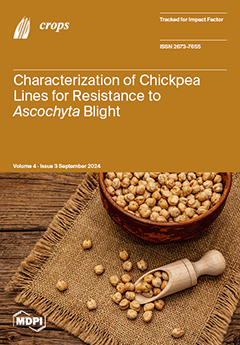To evaluate dryland wheat genotypes’ performance under different pre-crop and residue managements under dryland conditions, a split–split plot experiment based on the RCB design, with three replications, was conducted for two years (2017–2018 and 2018–2019). The site of the study has a long-term
[...] Read more.
To evaluate dryland wheat genotypes’ performance under different pre-crop and residue managements under dryland conditions, a split–split plot experiment based on the RCB design, with three replications, was conducted for two years (2017–2018 and 2018–2019). The site of the study has a long-term average precipitation, temperature, and relative humidity of 376 mm, 9 °C, and 50%, respectively. Wheat–wheat and vetch–wheat cropping systems were considered in the main plots, different wheat and vetch residue levels, including 0, 2, and 4 t ha
−1, were located in the subplots, and five dryland wheat genotypes, including Sadra, Hashtroud, Baran, Varan, and Ohadi, were allocated in the sub-sub plots. The results indicated that the leaf chlorophyll content index (CCI) and stomatal conductance (gs) were greater in the vetch–wheat cropping system compared to the wheat monoculture system for all genotypes. The normalized difference vegetation index (NDVI) of the genotypes improved by applying the crop residue. Over two years, the application of crop residues resulted in higher variable fluorescence at the J and I steps, as well as an increase in the photosynthesis performance index (PI). The Varan and Baran genotypes stood out as the superior genotype, exhibiting the highest values in physiological characteristics and grain yield under the application of 4 t ha
−1 of vetch residue. The grain-filling rate (GFR) was reduced, while the grain-filling duration (GFD) was increased with increasing the crop residue levels. The enhanced grain yield of the wheat genotypes grown under vetch residue was attributed to factors such as improvement in leave pigments and photosynthetic efficiency, which facilitate longer grain filling duration, with high grain weight. As a result, it is advisable to adopt a vetch–wheat cropping system with a high proportion of crop residue in dryland regions to achieve increased and sustainable wheat production.
Full article





